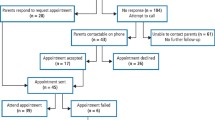Abstract
Design
Split-mouth randomised controlled clinical trial.
Intervention
School-based dental sealant (SBDS) programme. The study population that was selected from 67-year-old pupils of 16 elementary schools in areas of low socioeconomic status within Nice, France. Children with first permanent molar pairs sufficiently erupted for sealing with no caries (ICDAS [International Caries Detection and Assessment System] 0) or initial enamel lesions (ICDAS 1–2) were included. Children were randomised to either the intervention group (light polymerised resin-based sealant with fluoride) or the control group (no treatment).
Outcome measure
The primary outcome measure was caries with sealant retention as a secondary outcome.
Results
Four hundred and fifty-seven pairs of permanent first molars belonging to 276 school children were randomised. At three years 378 pairs in 228 children were available for analysis. The overall retention rate was 32.3%. Sealed molars had 67% less risk of new carious lesions, adjusted hazard ratio = 0.33(95%CI; 0.24-0.46).
Conclusions
SBDS programmes can be effective in preventing the development of carious lesions in school children, particularly those who come from low socioeconomic backgrounds and may, as a result, be unable to receive adequate oral healthcare in other settings outside the school. ICR should determine the selection of at-risk sub-groups for which the intervention could be considered.
Similar content being viewed by others
Commentary
Although the global burden of dental caries has been decreasing over the past few decades, health inequalities still exist among lower socioeconomic groups, with children having the highest prevalence.1 This reduction is largely attributed to preventive interventions such as fluorides, toothpastes, dental sealants, healthier diets, public health education and improved dental care. It has been theorised that those disparities may be due to the fact that the benefits of prevention are not reaching the aforementioned groups.1 Since occlusal pits and fissures are the most common sites for carious lesions to develop, evidence suggests that dental sealants have a positive effect in preventing and controlling caries in both children and teenagers. School-based dental sealant programmes in particular have been shown to be cost-effective in the long run, especially when the cost of subsequent fillings and disability-adjusted life-years caused by decayed teeth are considered.2
A systematic review that included parallel and split-mouth RCTs in both private and non-private settings, has concluded that sealants can prevent new caries occurrence for up to two years.3 As a result, initial carious lesions as well as decay-free teeth have been receiving sealants to arrest further caries development or stop its initiation. Although the evidence for SBDS programmes have been demonstrated in the literature before, there have been no randomised controlled trials carried out on the subject.4 Therefore, the aim of this trial was assessing how effective are SBDS programmes over a follow-up period of three years. Additionally, the secondary aims were (i) to evaluate the risk factors associated with new caries occurrence, (ii) to assess the programme's effectiveness with regard to those factors as well as (iii) to check the retention of the sealant material within said period.
This well-designed French study builds upon a previous RCT that was conducted in 2013 by the authors where the participants were followed for one year. A split-mouth design was used to adjust for any potential confounders by removing most of the inter-individual variability. The study population is well-defined and both the inclusion and exclusion criteria are clearly specified. Due to the nature of the intervention itself, blinding would not have been a viable option but the intervention as well as the outcomes are identified in a clear manner. Random treatment-control allocation sequence was computer generated. All of the participants are accounted for and included in the final intention-to-treat analysis. Independent variables are equally comparable between the control and treatment groups, hence the effects of confounding factors on the outcomes are minimised.
In terms of the results, the survival analysis showed that first permanent molars that received sealants had 67% (adjusted HR: 0.33; 95% CI: 0.24–0.46) lower risk of developing new carious lesions during all the follow-up than molars without sealant. In addition, children with carious lesions ICDAS 3-6 on permanent and primary teeth, that is, high ICR, had three times the risk of having a new carious lesion than others without, independently of the sealant treatment (adjusted HR: 3.00; 95% CI: 1.55–5.75). Effectiveness of the SBDS programme at three years of follow-up depended on the presence of carious lesions ICDAS 3–6 (HR in 173 children with carious lesions: 0.32; 95% CI: 0.23–0.46) at baseline (HR in 103 children without carious lesions: 0.42; 95% CI: 0.16–1.12). Finally, the overall fissure sealant retention rate was 32.3%.
With a study power of 80% and a significance level of 5%, the sample size required was 223 children. An additional 25% were added to compensate for any prospective dropouts and the final sample size was 276 children if only one pair of molars per child was to be included. Evidently, the results can be generalisable but their applicability will depend upon a multitude of factors including the costs required for such programmes to be carried out on a wider scale in the future. One weakness of this study is the lack of financial reporting, which could have added to the existent body of evidence in favour of the cost-effectiveness of SBDS programmes. The context within which the intervention was administered (ie schools located in low SES areas) is relevant only if the costs of the treatment can be justified and weighted against the potential long-term harms caused by other less effective alternatives. Another issue to be considered is absence of blinded clinical assessors in the first, second and third years follow-up; the relatively considerable confirmation bias of the involved clinicians cannot be overlooked.
This split-mouth randomised clinical trial gives moderate quality evidence in favour of the effectiveness of school-based dental sealant programmes. The implementation of such programmes should be dependent on the individual caries risk; in other words, children who are at higher risk of developing caries will benefit more from school-administered sealant treatment. Vulnerable children, identified as those less likely than their peers to receive dental care in private clinics, should have the priority to be considered for this sort of public health preventive measure.
References
Bagramian RA, Garcia-Godoy F, Volpe AR . The global increase in dental caries. A pending public health crisis. Am J Dent 2009; 22: 3–8.
Griffin S, Naavaal S, Scherrer C, Griffin PM, Harris K, Chattopadhyay S . School-Based Dental Sealant Programs Prevent Cavities And Are Cost-Effective. Health Aff 2016; 35:2233–2240.
Ahovuo-Saloranta A, Forss H, Walsh T, et al. Sealants for preventing dental decay in the permanent teeth. Cochrane Database Syst Rev 2013; 3:CD001830.
Muller-Bolla M, Lupi-Pégurier L, Bardakjian H, Velly AM . Effectiveness of school-based dental sealant programs among children from low-income backgrounds in France: a pragmatic randomized clinical trial. Community Dent Oral Epidemiol 2013; 41: 232–241.
Author information
Authors and Affiliations
Additional information
Address for correspondence: Michéle Muller-Bolla, Faculté de Chirurgie Dentaire, 24 Avenue des Diables Bleus, 06357 Nice Cedex 4, France. E-mail: michele.muller@unice.fr
Muller-Bolla M, Lupi-Pégurier L, Bardakjian H, Velly AM. Effectiveness of school-based dental sealant programs among children from low-income backgrounds: a pragmatic randomized clinical trial with a follow-up of 3 years. Community Dent Oral Epidemiol 2016; 44: 504–511.
Rights and permissions
About this article
Cite this article
Himida, T., Promise, U. School-based dental sealant programmes may be effective in caries prevention. Evid Based Dent 18, 13–14 (2017). https://doi.org/10.1038/sj.ebd.6401218
Published:
Issue Date:
DOI: https://doi.org/10.1038/sj.ebd.6401218
This article is cited by
-
Clinical performance of sealants under different humidity control conditions: a split-mouth 1-year randomized trial
European Archives of Paediatric Dentistry (2023)
-
Comparative effectiveness of school-based caries prevention: a prospective cohort study
BMC Oral Health (2018)



